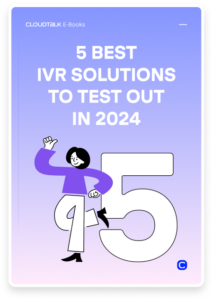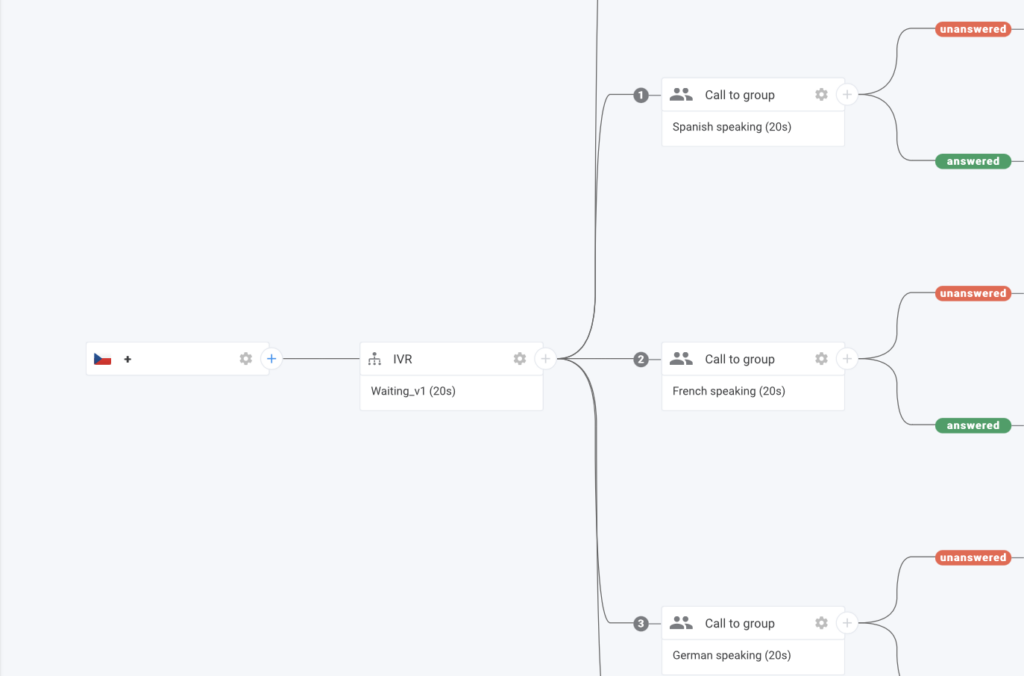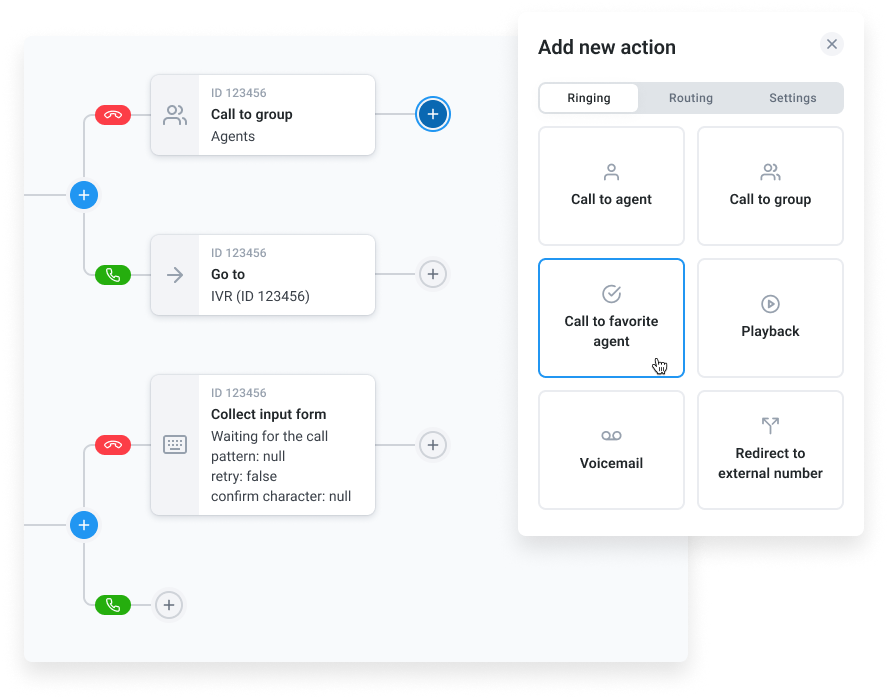6 Top IVR Routing Strategies to Improve Customer Journeys

Two thirds of customers who believe a company cares about their emotional state will likely become repeat customers. And nothing says “you’re valuable to us” more than a speedy, efficient call center experience, which will also build customer relationships and loyalty fast.
The way you route customer calls has a huge impact on the speed and efficiency of call resolution. So, optimizing your contact center routing strategy is one of the very best things you can do for your customers and your business.
IVR technology offers several sophisticated ways to route your calls. Here, we’ll go into six of the very best IVR routing strategies available.
Key Takeaways:
- The right IVR routing strategy can make a huge difference to average waiting times and customer satisfaction for those who reach out to your call center.
- There are many ways to route IVR calls, including routing according to customer’s location, customer’s past interactions, and available agent skill sets.
- Cloud IVR solutions offer a very cost-efficient way to implement sophisticated call routing strategies. Check out our IVR system pricing guide to find out more.
What Is IVR and How Does It Work?
Interactive Voice Response (IVR) is a system that allows customers to interact with your call center system so it can route them toward the fastest possible resolution.
Typically, a caller connects to an IVR menu when they contact your call center and gets presented with a range of options. They then either use their keypad or their voice to choose the right option for them.
Working with Automatic Call Distribution (ACD), and call routing functionality, the system then directs the caller to the best place to get the answers they need.
How a Hosted Contact Center Works
With a hosted contact center solution, you pay a subscription fee to a third-party provider, who then gives you access to the hardware and software you need. The provider is responsible for updating and maintaining the solution, taking those concerns off your shoulders.
Boost CSAT & Lower Churn with the 5 Best IVR Solutions in 2025

The Best IVR Routing Strategies to Streamline Customer Interactions
IVR call routing is a specific subsection of call routing that involves directing callers to the right person using interactive voice prompts. The routing system verbally talks each customer through a series of routing menus.
If you want to know more about call routing in general, we have a comprehensive call routing guide.
Now, let’s discuss an AI-powered IVR. It can do more than simply route customers according to recognized spoken prompts or keypad presses, too. It can route your customers intelligently, using factors such as customer data from available resources like linked CRM systems.
The IVR routing strategy you choose will determine how your IVR distributes calls.
There are several IVR routing strategies to choose from. Let’s go through some of the most popular:
Direct Routing
Direct routing is relatively simple. Callers can pick from a range of departments/services, and will be routed directly there. You’re probably familiar with the “Press one for sales, press two for payments…” contact center format. However, direct routing can also work via voice recognition.
Let’s say, for example, that an incoming caller wants to pay a bill. In a typical direct routing setup, the IVR will ask them which service/department they require. The caller will say something like “Payments” or “Pay my bill”, and the IVR will send them straight to the payment department.
Skills-Based Routing
Skills-based routing is a bit more complicated than direct routing and is useful for more complex calls.
For example, a help center dealing with technical issues may benefit from skills-based routing, as callers are likely to need specific skills and knowledge to solve their issues.

With a skills-based routing strategy, your IVR will consider your customer’s needs as provided by their responses to the menu options. Then, it cross-references what it learns with the data it has on available agents. It will then route the caller to the best possible agent to meet their needs.
Skills-based routing, together with a strong team of agents, is great for solving customer problems quickly and efficiently.
Intelligent Data-Led Routing
Intelligent IVR routing, sometimes known as caller-based routing, uses the data you already have to determine the best route for each individual caller.
A business calling solution like CloudTalk—with its built-in IVR feature—integrates seamlessly with tools like your CRM and your marketing software. It can draw data from these tools to get the best possible insights about incoming callers, and route them based on these insights.
For example, a previous agent may have tagged in your CRM that a particular customer has an ongoing issue. The IVR can then use that data to route the customer to an agent who is familiar with their situation (perhaps that same agent), or to the department best equipped to help them.
Intelligent, data-led routing provides a highly personalized service that can save customers and agents a lot of time. It’s great for helping out high-value customers and dealing with urgent needs.
Time-Based Routing
Time-based routing directs calls differently depending on the time of day.
For example, during non-business hours, IVR might route callers to your out-of-hours service or voicemail.
Similarly, if you have customers spread across the world, calls that come into one timezone during non-business hours could be directed to an available agent in another timezone.
Time-based routing is great for taking the stress out of busy or short-staffed times. It can also save customers the frustration of waiting for unavailable agents, and get them through to an available agent or service as quickly as possible.
Location-Based Routing
Global businesses can benefit hugely from location-based routing. Rather than getting through to a centralized call center where agents may not be equipped to deal with specific regional issues, location-based routing will direct customers to the most appropriate center or agent based on their location.
Let’s say, for example, that you run a business with branches all over Europe. Location-based routing can direct customers to the branch closest to them.
Location-based routing is great for larger businesses or businesses with a global presence. With a cloud-based communications provider, you can easily set up a network of customer service agents to give you a local presence all across the world. For example, CloudTalk offers the best-in-market coverage of over 160 international numbers.
Self-Service Routing
Self-service is incredibly popular with younger generations. In 2022, Gartner discovered that 38% of millennial and gen Z customers would give up and drop out of any customer service interaction if they couldn’t resolve it themselves through self-service automation.
So, self-service routing is a good choice for businesses with younger customers.

Smart IVR and tools like CloudTalk’s Call Flow Designer make it easy to set up automated self-service routes for simpler transactions. For example, with the right data and integrations, things like payments and appointments can be made easily via smart IVR without the need to interact with a human agent.
Choose the Right IVR Routing Strategy and Boost FCR Rates
So, you have plenty of options for your IVR call routing strategy. Pick the one that best suits your business and your customers, or devise your own, unique strategy.
You can easily customize and create the very best IVR call routing strategy for you with CloudTalk.
To find out how IVR, our intuitive call flow designer, and other features work give us a call or start a free trial.
IVR Routing FAQs
Which Type of IVR Routing is Best for My Business?
The best type of IVR routing for your business depends a lot on what you do, how you operate, and what your customers prefer.
For example, a business that’s spread over several countries could benefit from a local call routing strategy that gets customers through to an agent that speaks their language and is familiar with their regional issues.
A business with a younger customer base will benefit from plenty of self-service options. A self-service routing strategy will direct incoming callers to self-service options where possible rather than to agents.
If customers are likely to be calling with complex issues that require skilled help, a skills-based routing strategy will quickly get them through to the person best qualified to help them.
So, when deciding the best routing strategy for your business, think about what you and your customers need most.
What’s the Difference Between IVR and ACD?
Both IVR (Interactive Voice Response) and ACD (Automatic Call Distribution) are used to route calls to the right agent or department. But they’re not the same thing.
An ACD system is essentially the call router. It’s the technology that sends callers to an agent, service, or department based on the business’ call routing strategy.
An IVR system is also involved in routing calls, but by gathering data and interacting with customers to discover where it’s best for the ACD to send them.
IVR and ACD, then, aren’t opposing systems, they work together. An IVR acts as the “front of house”, feeding data to the ACD, which then quickly routes the customer to the right agent/service.
How Can I Set Up an IVR Call Flow?
It’s simple to set up an IVR call flow with CloudTalk’s intuitive Call Flow Designer. You can create completely bespoke customer call journeys from start to finish with ease. Learn more about how it works here.
























